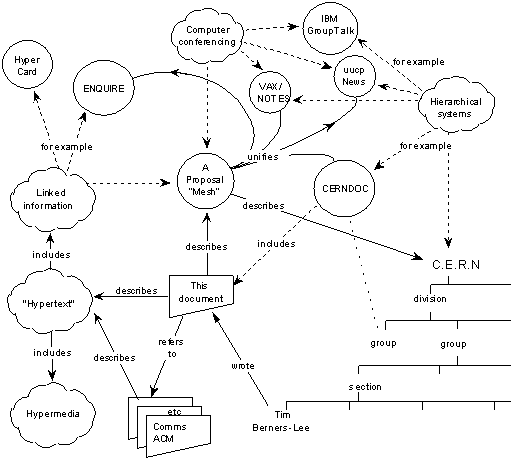Digital Infrastructure is Infrastructure
Suppose that thirty something years ago, you were a middle manager at a large international bureaucracy, and a proposal landed on your desk that began like this:
Multimedia is a way to link and access information of various kinds as a honeycomb of nodes in which the user can flit at will. It provides a single user-interface to large classes of information (reports, notes, data-bases, computer documentation and on-line help). We propose a simple scheme incorporating servers already available.†
It continues:
The project has two phases: firstly we make use of existing software and hardware as well as implementing simple readers for the user’s workstations, based on an analysis of the requirements for information access needs by experiments. Secondly, we extend the application area by also allowing the users to add new material.
Phase one should take 3 months with the full manpower complement, phase two a further 3 months, but this phase is more open-ended, and a review of needs and wishes will be incorporated into it.
The manpower required is 4 software engineers and a programmer, (one of which could be a Fellow). Each person works on a specific part (eg. specific platform support).
Each person will require a state-of-the-art workstation , but there must be one of each of the supported types. These will cost from 10 to 20k each, totalling 50k. In addition, we would like to use commercially available software as much as possible, and foresee an expense of 30k during development for one-user licences, visits to existing installations and consultancy.
And here’s the yarn on a bulletin board diagram that comes with it:

Surely any competent manager would think that this is 80,000 in (pre-inflation!) taxpayer money about to go straight down the toilet to any overly ambitious pie-in-sky project that couldn’t possibly deliver anything more than a novelty at best. Time to grab the big red stamp: Rejected!
Except it did work. You’re reading this on the web today.
† Okay, I fudged and changed the words “hypermedia,” “web,” and “browse” to make it less obvious what the proposal was.
The web shouldn’t have worked. An ambitious project to “link and access information of various kinds” is exactly the kind of thing that tended to eat up a decade with nothing to show for itself but some nice demos. Aren’t grant analysts supposed to take past failure and overweening hubris into account when they make their funding decisions?
This leads to two questions: Why did it work? And how can we make sure the Tim Berners-Lees of today get a chance to pursue their dreams?
When comparing the World Wide Web to past hypermedia systems, the web is clearly simpler. It didn’t try to reinvent the whole operating system or network stack. It just added simple and extensible text based protocol and document formats to the existing internet. An interesting contrast is Berners-Lee’s semantic web, which never went anywhere because it was basically a Cyc-style boil-the-ocean attempt to recreate the web from scratch, but with proper semantics this time. Microdata and later JSON-LD have done a much better job precisely because they are just enhancements to the web and not replacements for it.
As for how we can make sure the next Tim Berners-Lee gets their 80K and 6 months of 5 FTEs, I think the answer is clear.
Let's play Unpopular Opinions! 🤘
— Go Time ⏰ (@GoTimeFM) April 8, 2021
@carlmjohnson thinks there should be a system for government funding of open source software 🔥
✂️ from https://t.co/WmUZWxqK8g #golang pic.twitter.com/UfwvvBQAEz
In the twenty-first century, it’s time for governments to step up and fund open source regularly and proactively rather than hoping that some physics contractor manages to craft a grant that sparks the next information revolution. Key digital infrastructure is reduced to lame pleas for sponsors or scraping together funding from disparate sources. It doesn’t have to be this way. Digital infrastructure is infrastructure. Let’s act like it.